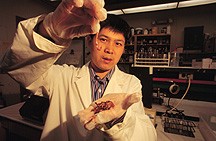As the earthworm turns: Aging DDT in soil could be less hazardous than previously feared, Cornell tests show
By Roger Segelken
The tests currently used to detect old DDT and other organic pollutants in the soil may overestimate the risk to living organisms, according to Cornell researchers who say the real issue for government regulators at toxic cleanup sites should be "biological availability" of aging toxins.
A report to be published in the Dec. 15 issue of the American Chemical Society journal Environmental Science & Technology finds new tests for this so-called "bioavailability" -- the amounts of toxins available to harm organisms -- to be a more realistic reflection of the potential harm of organic pollutants to humans, animals, plants and ecosystems.
And the new tests of bioavailability meet "standards" set by a living inhabitant of the soil, the common earthworm.
"Recent research has cast doubt on the validity of current analytical methods for assessing the risk from organic pollutants in soils," said Martin Alexander, Cornell's Liberty Hyde Bailey Professor of Soil Science and co-author, along with research associates at Cornell, of the journal report. "Current methods determine the total concentration of compounds, not the amounts that are actually available to do harm. If we are not measuring bioavailability, we are overestimating -- sometimes appreciably -- the risk to biological organisms."
The Cornell study focused on soils that were contaminated over the years with DDT and its derivatives DDE and DDD, using two different procedures to determine bioavailability: solid-phase extraction with C18 membrane disks and liquid-phase extraction with aqueous solutions containing tetrahydrofuran.
DDT is the common name for 1,1,1-trichloro-2,2-bis(p-chlorophenyl)ethane, the synthetic insecticide banned for use in the United States since 1972 but still present in some soils, as are its chemical cousins, DDE or 1,1-dichloro-2,2-bis (p-chlorophenyl)ethane and DDD or 1,1-dichloro-2,2-bis(p-chlorophenyl)ethylene
To gauge the effects of chemical aging on bioavailability, the researchers used soil that was treated with DDT 50 years ago in U.S. Department of Agriculture test plots in Maryland, soil contaminated with DDT about 30 years ago at a U.S. Navy weapons-testing site in Virginia, and uncontaminated New York state soils, which the researchers deliberately treated with DDT, DDE and DDD.
Age can be an important factor in bioavailability, Alexander explains, because the compounds might be sequestered in the soil and are less likely to be absorbed by living organisms. The usual way of determining chemical contamination, vigorous extraction methods, detected more DDT, DDE and DDD in the soil samples -- as was expected -- compared to the bioavailability tests.
"We have devised an analytical procedure that actually determines the bioavailability of three major pollutants that are often present in unacceptably high concentrations in soil and aquatic sediments," Alexander said. "Although our method is a simple chemical procedure, we have shown results that correlate well with the amounts that are available to our test animal species," the earthworm.
Using bioavailability measurements, Alexander said, "should permit better assessment of risk and allow for more meaningful decision-making at sites that require remediation."
The study, reported as, "Chemical-Extraction Methods to Estimate the Bioavailability of DDT, DDE, and DDD in Soil," was conducted by Jixin Tang and Boakai K. Robertson, both research associates working in Alexander's lab. The study was funded by the National Institute of Environmental Health Sciences and the U.S. Environmental Protection Agency.
A report on studies of similar bioavailability tests for polycyclic aromatic hydrocarbons, the common pollutants from oil spills and manufactured-gas plants, is set for publication in the journal Environmental Toxicology and Chemistry.
Media Contact
Get Cornell news delivered right to your inbox.
Subscribe